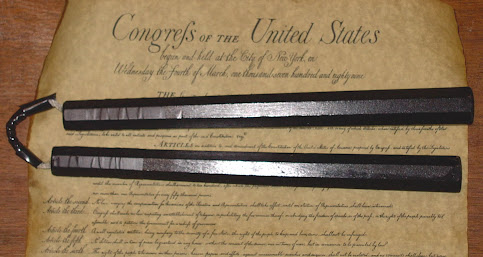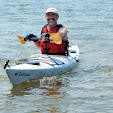What About Massachusetts?
Massachusetts still has a nunchaku ban. It appears to be the last surviving specific ban on nunchaku in any state. Arizona’s and California’s legislatures repealed their bans after Maloney v. Singas was decided.
Click on the nunchaku at left for the text of Massachusetts General Laws, Chapter 269, section 10(b), which prohibits not only carrying nunchaku or having them in a car, but even the wearing of a spiked wristband! (My leftover from the punk era is shown in the photo accompanying the quoted statute.)
Under the rather draconian Massachusetts statute, mere possession of nunchaku (or of a spiked wristband, or of a “zoobow,” whatever that may be...) is considered a felony and could result in a sentence of up to 2½ years in state prison even with no prior record! As one Boston law firm’s website explains:
Stay tuned for more. Meanwhile, if you live in Massachusetts and have knowledge of recent arrests and/or prosecutions for nunchaku possession, please email me at nunchakulaw[at]gmail[dot]com.
Jim Maloney
Gravity Knife News Summary (~November 2020)
Jim Maloney
Older News about the Nunchaku Case (with IMPORTANT WARNING) (January 26, 2019)
On December 14, 2018, the United States District Court for the Eastern District of New York rendered a final decision in Maloney v. Singas, my pro se constitutional case, striking down virtually all of the provisions of the New York Penal Code that ban the possession, sale, manufacture, or transfer of nunchaku. In doing so, the Court granted relief somewhat beyond what I had asked for (but I am not about to complain). Thanks to the many who have helped in many ways along the way. It has been a path with heart.
A pdf copy of the Court’s December 14, 2018, findings of fact and conclusions of law (the decision) may be viewed or downloaded by clicking here.
The decision was not appealed, so it is now legal to possess nunchaku in New York. But...
IMPORTANT WARNING: Displaying, swinging, or twirling nunchaku in public within the State of New York could still give rise to criminal charges (menacing, disorderly conduct, etc.). Please respect those around you by practicing only in safe and private locations where no bystanders can be injured or intimidated.
Jim Maloney (aka “Professor Nunchucks”) 
Opening statement (January 9, 2017)
The trial we are about to begin concerns the right of the people to keep and bear arms. As recently as ten years ago, the Supreme Court still had not given meaning and content to the provision in the Constitution that sets forth that right, although the Second Amendment has been part of our Constitution since 1791. Today, the balance between the exercise of that right and the recalcitrant plague of gun violence in America is finally beginning to be worked out. It will probably take decades for the courts and the legislatures to strike that balance in a way that protects us all from such horrific incidents as mass shootings at schools, movie theaters, and airports, while at the same time guaranteeing that the Second Amendment, which was first applied to the states only 6½ years ago in McDonald v. Chicago, is given real meaning and substance. Actually, we may never get it right, but I try to be an optimist, because I believe that the “path of the common law,” as Justice Oliver Wendell Holmes Jr. put it, is also, as Carlos Castaneda put it through his character Don Juan, a “path with heart.” Nothing in this case has anything to do with guns, or with carrying weapons on the street, or with mass shootings at schools, movie theaters, or airports. And yet, this case has everything to do with all of those things, because the path of the common law is also in some ways like the path of a particle in a quantum physics experiment: it travels in many different directions, all at once, because precedents are often applied in ways that aren’t always foreseen, or even reasonably foreseeable, when they’re made. So there is actually a lot more at stake here than might meet the eye at first glance. Can we get it right? Well, we can try. Right now the only question before us is whether the nunchaku, an ancient martial arts weapon, is commonly used for lawful purposes today. In a few years, the key Second Amendment questions may be somewhat different, so I ask the Court to be patient if it appears that at times I am straying from the path the Court has defined in order to establish a record that may become relevant down the road. And I also ask the Court to remember that the relief I’m seeking here, and have been seeking for nearly 14 years now, is real, and personal, separate and apart from all those big-picture considerations I’ve just described. But I have a duty, I think, to try to address both. Is it possible for me, one human being, acting alone, to fulfill that duty? No.
















